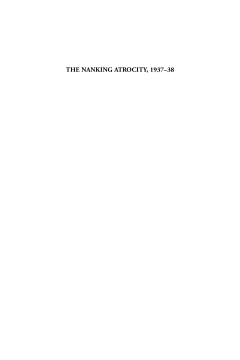
Additional Information
Book Details
Abstract
First published in 2007, The Nanking Atrocity remains an essential resource for understanding the massacre committed by Japanese soldiers in Nanking, China during the winter of 1937-38. Through a series of deeply considered and empirically rigorous essays, it provides a far more complex and nuanced perspective than that found in works like Iris Chang’s bestselling The Rape of Nanking. It systematically reveals the flaws and exaggerations in Chang’s book while deflating the self-exculpatory narratives that persist in Japan even today. This second edition includes an extensive new introduction by the editor reflecting on the historiographical developments of the last decade, in advance of the 80th anniversary of the massacre.
SECOND EDITION
Praise for the First Edition
“A refreshingly candid response to Japanese scholarship that denies or minimizes the attack on Nanking in order to advance contemporary jingoistic politics … Highly recommended.” · Choice
“All of the articles in the volume are essential reading for anyone interested in the subject.” · The Historian
“These essays provide a compelling refutation of the tired and implausible arguments typically espoused by the deniers and minimizers and also vividly portray the various atrocities committed by the Imperial Armed Forces. This collection also offers refreshing counterpoints to the hyperbole that biases - and undermines - Chinese accounts of the tragedy.” · Japan Times
Bob Tadashi Wakabayashi is Emeritus Professor of History at York University, Toronto. He specializes in Japanese political thought and World War II in East Asia.
Table of Contents
| Section Title | Page | Action | Price |
|---|---|---|---|
| Contents | v | ||
| Acknowledgments to the Second Edition | vii | ||
| Preface to the First Edition | ix | ||
| Wade-Giles to Pinyin Conversion Table | xii | ||
| Maps | xvi | ||
| Iris Chang Reassessed: A Polemical Introduction to the Second Edition | xxi | ||
| Chapter 1 — The Messiness of Historical Reality | 3 | ||
| Chapter 2 — The Nanking Atrocity: An Interpretive Overview | 29 | ||
| Section One — War Crimes and Doubts | 55 | ||
| Chapter 3 — Massacres outside Nanking City | 57 | ||
| Chapter 4 — Massacres near Mufushan | 70 | ||
| Chapter 5 — Part of the Numbers Issue: Demography and Civilian Victims | 86 | ||
| Chapter 6 — The Nanking 100-Man Killing Contest Debate, 1971–75 | 115 | ||
| Chapter 7 — Radhabinod Pal on the Rape of Nanking: The Tokyo Judgment and the Guilt of History | 149 | ||
| Section Two — Aggressors and Collaborators | 179 | ||
| Chapter 8 — Letters from a Reserve Officer Conscripted to Nanking | 181 | ||
| Chapter 9 — Chinese Collaboration in Nanking | 196 | ||
| Chapter 10 — Westerners in Occupied Naking: December 1937 to February 1938 | 227 | ||
| Chapter 11 — Wartime Accounts of the Nanking Atrocity | 248 | ||
| Section Three — Another Denied Holocaust? | 265 | ||
| Chapter 12 — The Nanking Atrocity and Chinese Historical Memory | 267 | ||
| Chapter 13 — A Tale of Two Atrocities: Critical Appraisal of American Historiography | 285 | ||
| Chapter 14 — Higashinakano Osamichi: The Last Word in Denial | 304 | ||
| Chapter 15 — Nanking: Denial and Atonement in Contemporary Japan | 330 | ||
| Postscript | 355 | ||
| Chapter 16 — Leftover Problems | 357 | ||
| Appendix | 394 | ||
| Bibliography | 399 | ||
| Notes on Contributors | 421 | ||
| Index | 423 |
